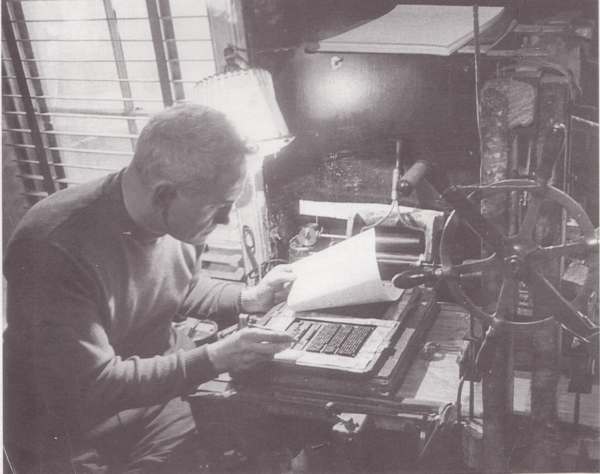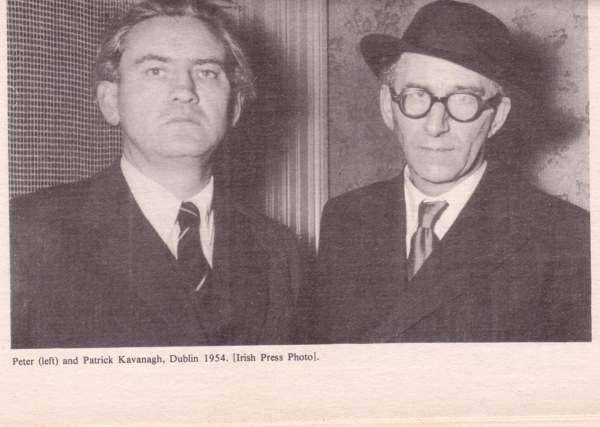
JULY 2006

Dr. Peter Kavanagh.
I was acquainted with Dr. Peter Kavanagh only briefly in the last year, 2005, of his life; longer with his writings on the theatre and longer still in curiousity as to who this brother of the poet, Patrick Kavanagh, could be – whom a posse of writers and artists used abuse in conversation.
Peter Kavanagh wrote
extensively on the theatre in Ireland in two volumes, and
he wrote with persuasive authority and lively opinion. As
Patrick, ( whose family always used his name, Patrick,
and never "Paddy" in the hated Dublin
vernacular) wrote to his brother in reference to his
manuscript of The History of The Abbey Theatre
"...the Higgins-O'Connor
time is vivid and alive and shows that it excited you.
Your personality comes through and the author's
personality is an important part of the truth."
In addition in this volume he revealed immense
persistence investigating abstruse or difficult texts of
reference. Singularly, he examined the scarcely
penetrable handwritten diaries of Joseph Holloway and
mined treasures of the past.
Peter and Patrick developed a brotherly unity of purpose
that is quite remarkable. For all the times Peter's
criticism of Patrick's texts written and re-written,
Paddy too gave as good as he got. Regarding the reference
above Paddy gave the ms. strong abuse though alleviating
the blow in a postscript - "When I look through
it again I change my mind." However this led to
a scrutiny of the text by Peter and an editor of
Garrity's which discarded 15,000 words ! This History of
the Abbey Theatre as it reads now is a powerful appraisal
of Yeats dedication to a poetic ideal. The New York Times
Book Review, such an important source for thousands of
American tourist audiences in that theatre,described the
book as an impartial history and the best book written on
the subject.
Peter Kavanagh shared with his brother in his youth a
strong interest in mythology of the area in which they
were born - on the threshold of the history of Cuchulain,
in sight of the Gap of the North through which armies
both from and into Ulster marched, in the vicinity of the
sacred mountain, Slieve Gullion. Peter wrote a small book
at the death of his brother about their townlands. He
also wrote a Dictionary of Irish Mythology and there
Patrick wrote :
"I never felt the same, or anything like it,
about any Christian shrine. The shrines were literal. No
miracles...all the miracles were pagan miracles and
touched with pantheism..........The satisfying quality in
these ideas is the absence of limits. They project beyond
mortality. The soul must expand or die...."
You may be thinking that I touch lightly on the
history of this man whose relationship with his brother
presents us unequivocally with Patrick Kavanagh's poems,
letters and texts. But this is the writing, with much of
his emotion, in both specific texts and the quality of
expression throughout, that Peter Kavanagh was involved
in. He was responsible for urging his brother, crucially,
to work on his two great poems The Great Hunger
and Lough Derg.
In schools here in Ireland of the much loved poems
in the school syllabus, the children perhaps only hear of
Dr. Kavanagh creating with his brother Kavanagh's
Weekly, the thirteen issues of which
invaded the stultifying atmosphere of literary academic
rigor mortis that then pervaded Dublin. Writing completed
under several pseudonyms and covering with outspoken
opinion the events of the time, 1952.
But Peter Kavanagh's own academic career brought him much
satisfaction - he moved to America where he taught in
Universities in Chicago, Pennsylvania and Wisconsin as
Professor of Modern Poetry. In 1958, maintaining a
residence in New York, he built his own Printing Press
with one purpose in mind - to print poems of Patrick's
that were being ignored by commercial publishers, and to
print the first ever volume of Patrick Kavanagh's
Collected Poems. He never let his close association with
Patrick drop as can be confirmed in hundreds of letters
collected in Lapped Furrows, another of his
publications in later years. Building this press he says:
I made it out of wood with two aliminium plates half an
inch thick, attached to an old (1893) Singer sewing
machine which I bought for five
dollars.................it will take a little
experimentation to get the bugs out of my press but I
will eventually manage that...........It will take me
some time to set a book, for I will have type for only
one page at a time." Later that year he wrote
to Patrick: I have now mastered my Press - never have
I tackled a more difficult job ..........I am not
stopping now that I have got started.... though learning
a trade in weeks that normally takes years.
Such was his eagerness to print a volume of his brother's
work. He finally threw this press on to the street in
August 1962 and planned to install a commercial press in
an appartment."Hand setting (of the print)
is beautiful, but the work involved is beyond the beyonds
- I had to stop using my fingers." (However,
his widow, Mrs Anne Keeley Kavanagh, tells me that this
press was never thrown out except for pieces of it that
were discarded for improved replacements; and this Press
can now be seen in the Kavanagh Museum.)
Peter Kavanagh had graduated from the National University
of Ireland in 1941 and obtained a Ph.D from Trinity
College in 1944. He began his teaching career with the
Christian Brothers at Westland Row, Dublin, "a
barbarous environment,"where after a dispute
with a school inspector he was pushed into a dark
discarded classroom with 50 pupils. Of that time George
Coughlan, a pupil, wrote in later years:
"I can still sing those rebel songs you taught
us on your clarinet and you gave me an interest in
Theatre, literature and Music that persisted. It was the
most delightful year - the only time I received any
genuine education."
After his brother's death Peter began publishing a series
of books on his brother's life. He also published his Dictionary
of Irish Mythology and his autobiography Beyond
Affection.
We can say that Peter Kavanagh's life work, devoted
as it seems almost entirely to his brother's life
nevertheless also shows an author of importance and
authority. His volumes on the History of the Irish
Theatre and The History of the Abbey Theatre
are acclaimed texts both academically and of personal
vision. He stressed that Yeats brought about an original
theatre of the highest integrity dedicated to a poetic
ideal.
The Abbey Theatre was a dream in the mind of Yeats.
He made it a reality during his life, but when he died
the reality returned to the dream and passed away with
its creator. And elsewhere:He was guided always
by intuition, rarely by reason or expedience.
In addition he wrote of Sean O'Casey: "He was
Ireland himself - who wrote sincerely only out of his own
life and emotions. He was expressing the inner spirit of
Ireland. Dublin tenement dwellers are the most
essentially Irish group in the nation. He (O'Casey)
does not have to fight off that savage love of the soil
which would engulf the spirit. " and elsewhere:
"Dublin, while it produces writers has no sympathy
for them - and it is difficult to survive there and
produce good work"
In reference to one of Joseph Holloway's Diary entries he
amusingly quotes: "Yeats gave instructions for
the minimum of action - be statuesque - the actors spoke
to the audience instead of each other with their heads on
the side as if they had boils on their necks." Holloway
was surely a man after Peter's heart, he wrote of the
police attendances during performances of The Playboy of
the Western World - "This was freedom of the
theatre, according to Yeats, and his studies in blue
ranged along the walls like Tussaud's Waxworks." Or,
again, Holloway on St.John Ervine - "When a
Northener has talent combined with cheek there is no
holding him..."
Despite the difficulties of working under Edward
Martyn the theatre continued also after Yeats death to
give its best shots and Peter was able to confirm this
from his own experience in 1930 when he attended all its
productions, both new plays and revivals. Peter's high
excitement with theatre informs his exceptional ability
to re-create that excitement, and understand the
importance of theatrical experience for civilisation,
that sends one off to read or re-read Irish authors from
history to the present time. Writing of George Russel he
says : He (AE) realised that the greatest spiritual
evil one nation could inflict on another was to cut off
from it the story of the national soil.
At this point it is worth remembering those great men
George Petrie, John O'Donovan and Eugene O'Curry who
miraculously, perhaps urged by a spiritual apprehension
of the future, rescued so much of that history and myth
as it really existed among the Irish people in years
prior to the Famine. Any later, investigators would have
missed so much, and it entirely beyond recall. Even then
those fine men experienced that evil of national
repression when the British Authorities prevented them
continuing their geographic surveys of Place Names and
their histories. All the work subsequently was done
almost voluntarily and privately, but by those dedicated
men whose energy never seemed to tire.
I understand that Peter Kavanagh wrote regularly all his
life and it will certainly be of great interest to hear
of future posthumous publications by this sincere strong
man. And as to the scabrous abuse he suffered here in
Ireland, as did his brother Patrick in his time - one
wonders how many of the Irish writers and artists of note
wrote to him in his last years to apologise for their
brutal "brotherhood" of arrogance.
Jocelyn Braddell.
